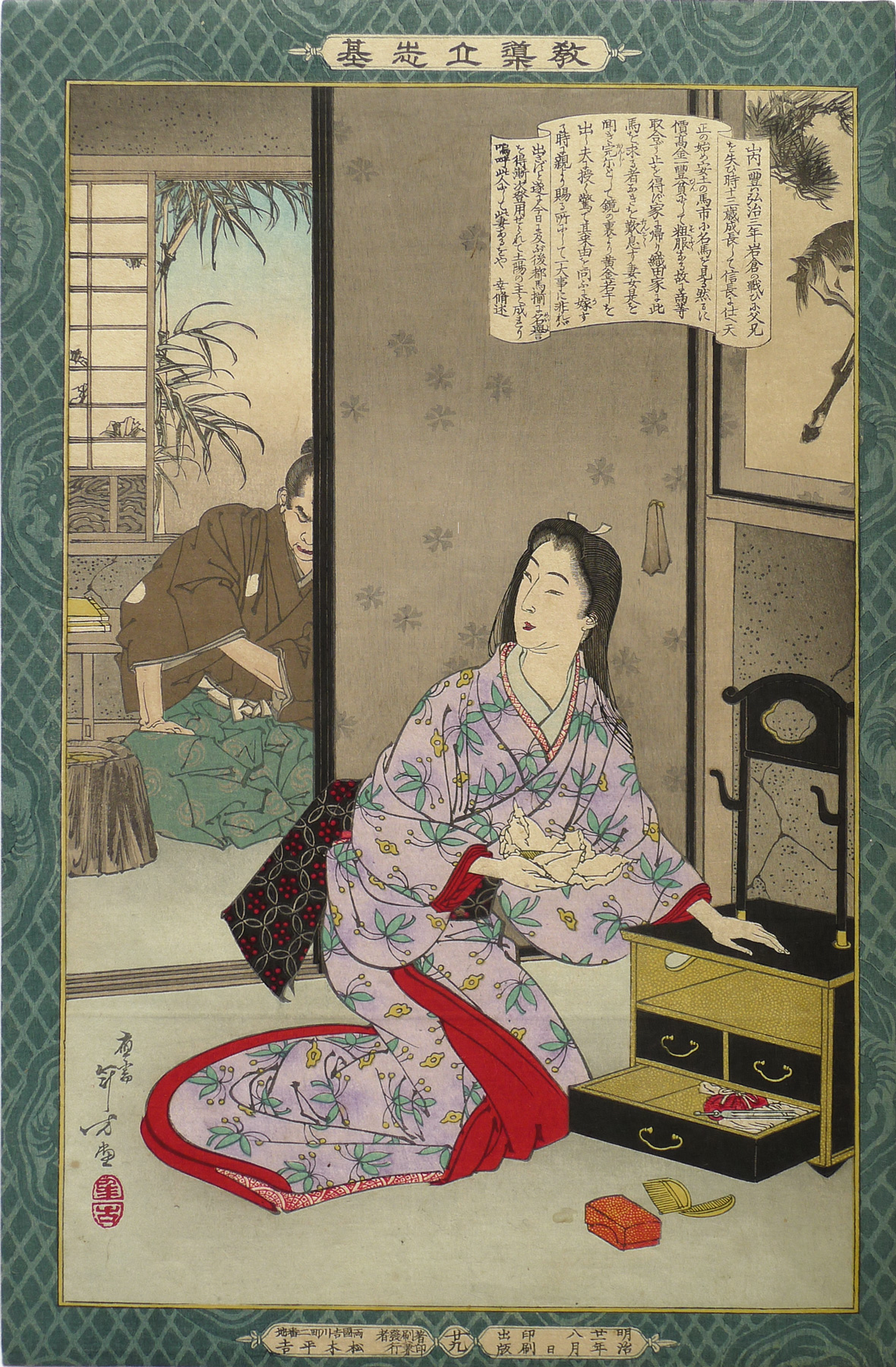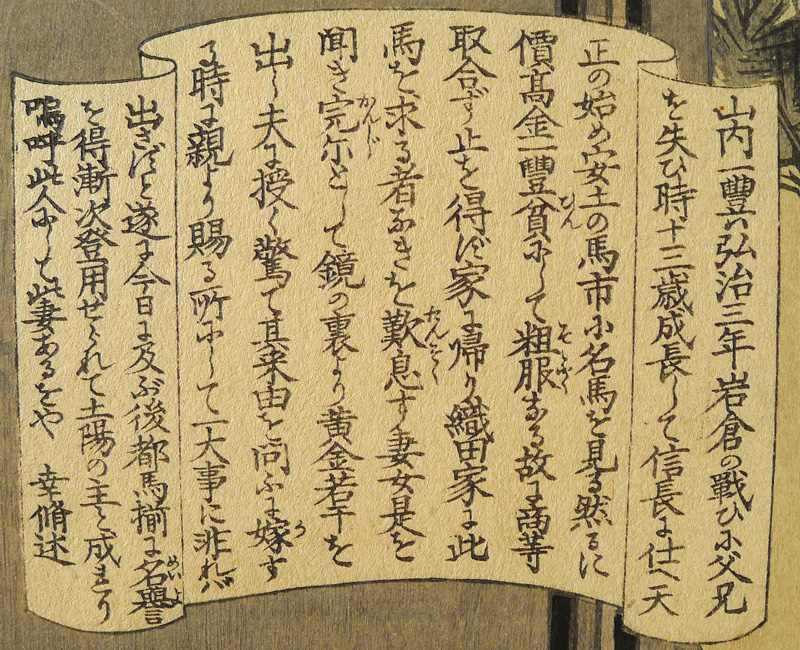About This Print
Print number 29 (廿九)1 in the series Instructive Models of Lofty Ambition picturing Yamanōchi Kazutoyo no tsuma (the wife of Yamanōchi Kazutoyo) gathering money from her mirror-table to give to her husband to buy an expensive horse. Her husband sits worrying that he cannot afford the horse and will lose the opportunity it can bring. The screen in the upper right bears the image of a horse.Toshikata contributed 16 prints to this series.
1 Numbering of the prints was haphazard during the production of the series. Print numbers were sometimes inadvertently omitted; some prints in the series were never assigned numbers and a few of the same numbers appear on different prints.
The Story of Yamanōchi Kazutoyo no tsuma
Source: We Japanese: Being Descriptions of the Characteristics, History, Legendry, Tradition, Drama, Images, Shrines, Temples, Customs, Manners Besides Numerous Other Subjects, Vol. II., Sakai Atsuharu, H.S.K. Yamaguchi, Fujiya Hotel, Ltd., 1937, p. 33.One day in the autumn of 1578 there came to the Azuchi castle of Lord Nobunaga Oda, in the province of Ohmi, a horse-dealer from Sendai, a town famous for its fine horses in the northern part of Japan. He had with him a splendid stallion, which was too dear for any samurai of the clan to buy. Kazutoyo Yamanouchi, a low-rank samurai of promise, felt very sorry that he could not buy the horse and went home quite dejected.
“What is it that ails you?” his wife asked when he got home. “It is nothing that concerns a woman,” was the cold reply, for in feudal days a samurai considered it a shame or something socially undignified to consult his wife on any matter relating to his duties. He appeared so disappointed, however, that his worried wife insisted upon knowing the nature of his trouble.
“There came a horse-dealer from Sendai,” Yamanouchi said at last, and he has a fine stallion, finer than any that we have here in the castle. But it is so dear that no samurai of the clan can afford to buy it, and I fear he may have to take the horse back. Its possession would mean immediate promotion for me. Nothing is harder indeed than poverty in life.”
“How much is the horse?” his sympathetic wife asked, after listening to what her husband had to tell her. “Why, ten ryō of gold, and the dealer would take no less,” Yamanouchi sighed crest-fallen. “Here is ten ryō” his wife said, offering her husband ten pieces of gold, which she took out of the drawer of her mirror-stand. “Take this and buy the horse.” “Where on earth did you get this large sum of money?” demanded the surprised husband evidently in ecstasy.
“My mother gave it to me when I married,” his wife said simply. “I have kept it in my mirror-stand all these years.” “When my mother gave it to me,” she went on to explain, “she told me never to spend it except on a thing of great consequence to my husband. When we were poverty-stricken, you being out of employment, for a long time, I never thought of using this money, but my mother’s words always rang in my ears and I restrained myself. I am glad that I have not waited in vain. Take then the money immediately and buy the horse before it is too late.”
There was a horse-display in the Azuchi castle a few days later, and Lord Oda took notice of the especially fine horse with Yamanouchi rode. The lord was very much pleased when it was explained how Yamanouchi, though of a low rank as samurai, had managed to buy the horse. “Double his allowance at once,” Lord Oda said, “not because he owns that fine horse, but because he saved us from shame and dishonour. If the horse-dealer had gone back taking the horse, we should have been made a laughing-stock for having no samurai who could buy one horse.”
Later on Yamanouchi was created a local daimyo or lord in the province of Tosa.
Transcription of Scroll
A scroll, present on each print in the series, contains brief historical details of the figure and scene being portrayed.
click on image to enlarge
Source: with thanks to Yajifun http://yajifun.tumblr.com/
29 Wife of Yamauchi Kazutoyo 山内一豊妻
教導立志基 廿九 山内一豊妻 水野年方 1888年8月
“山内一豊ハ弘治三年岩倉の戰ひに父兄を失ひ時十三歳 成長して信長に仕へ天正の初め安土の馬市に名馬を見る 然るに價高金 一豊貧にして粗服なる故に商等取合ず 止を得ず家に帰り織田家に此馬を求る者なきを歎息す 妻女是を聞き完尓(莞爾)として鏡の裏より黄金若干を出し夫に授く 驚て其来由を問ふに 嫁する時に親より賜る所にして一大事に非れバ出さずと 遂に今日に及ぶ 後都馬揃に名譽を得 漸次登用せられて土陽の主と成れり 嗚呼此人にして此妻あるをや 幸脩 述”
About The Series
Kyodo risshi no motoi (Foundations of learning and achievement or Instructive Models of Lofty Ambition)
Notes:1. This series is variously translated as "Instructive Models of Lofty Ambition," "Foundations of Learning and Achievement," "Foundation of Instruction and Perseverance," "Self-Made Men Worthy of Emulation," "Paragons of Instruction and Success," "Moral of Success," "Examples of Self-Made Leaders," and "Instruction in the Fundamentals of Success." The title in Japanese is sometimes seen as "Kyōdō risshiki or "Kyōdō risshi no moto," in addition to the most commonly seen transliteration of "Kyōdō risshi no motoi".
2. For a complete listing of all the prints in the series and additional information please see the article on this site titled Instructive Models of Lofty Ambition.
This series ran between October 1885 and November 1890 and featured a long list of heroes and heroines, from antiquity to contemporary times, who were regarded as standards of moral leadership and self-realization.
Source: Kiyochika Artist of Meiji Japan, Henry D. Smith II, Santa Barbara Museum of Art, 1988, p. 74-75; original research and as footnoted.
This series of 58 prints,1 plus a table of contents sheet (目録), were originally published between October 1885 and November 1890 by the Tokyo publisher Matsuki Heikichi 松木平吉.2 The table of contents sheet issued by the publisher states that "fifty prints make up the complete set (五十番揃)". Three prints not in the initial release were added over the five year publication period, as were five redesigns of original prints, eventually increasing the total print count to 58. The seven artists contributing prints were Kobayashi Kiyochika (1847-1915) [20 prints], Mizuno Toshikata (1866-1908) [16 prints], Inoue Tankei (Yasuji) (1864-1889) [13 prints], Taiso (Tsukioka) Yoshitoshi (1839-1892) [5 prints], Yōshū Chikanobu (1838-1912) [2 prints], Toyohara Kunichika (1835–1900) [1 print], and Hachisuka (Utagawa) Kuniaki II (1835-1888) [1 print]. All the artists, with the exception of Yōshū Chikanobu, are listed in the top scroll of the table of contents sheet. Various colors (including blue, blue/green, and tan/brown) were used for the decorative border, and in 1902 the series was re-issued by Matsuki without borders.
This series of 58 prints,1 plus a table of contents sheet (目録), were originally published between October 1885 and November 1890 by the Tokyo publisher Matsuki Heikichi 松木平吉.2 The table of contents sheet issued by the publisher states that "fifty prints make up the complete set (五十番揃)". Three prints not in the initial release were added over the five year publication period, as were five redesigns of original prints, eventually increasing the total print count to 58. The seven artists contributing prints were Kobayashi Kiyochika (1847-1915) [20 prints], Mizuno Toshikata (1866-1908) [16 prints], Inoue Tankei (Yasuji) (1864-1889) [13 prints], Taiso (Tsukioka) Yoshitoshi (1839-1892) [5 prints], Yōshū Chikanobu (1838-1912) [2 prints], Toyohara Kunichika (1835–1900) [1 print], and Hachisuka (Utagawa) Kuniaki II (1835-1888) [1 print]. All the artists, with the exception of Yōshū Chikanobu, are listed in the top scroll of the table of contents sheet. Various colors (including blue, blue/green, and tan/brown) were used for the decorative border, and in 1902 the series was re-issued by Matsuki without borders.
Brief texts contained within a scroll-like cartouche appearing on each print provide historical details. The scroll composer's name is given at the end of the scroll text. The “lofty ambition” of the title is a Confucian concept, originally from Mencius, meaning “righteous determination that would inspire others.” The market for the series probably included former samurai, ambitious youth, and conservative intellectuals.
"[W]hen it was completed in 1890 the publisher was singled out for special recognition by the government for having sponsored such noble subject matter."3
1 The Tokyo Metropolitan Library online collection shows 50 prints and a Table of Contents sheet. The Table of Contents lists the titles of 50 prints. Smith in Kiyochika Artist of Meiji Japan identified 52 prints. I have identified 58 prints from this series including five prints (Ikina, Michizane Sugiwara, Kesa Gozen, Soga Brothers and Hokiichi Hanawa) that were re-designed and re-printed, likely due to damaged or lost blocks.
2 Robert Schaap notes in Appendix II, p. 166 of Yoshitoshi, Masterpieces from the Ed Freis Collection, Chris Uhlenbeck and Amy Reigle Newland, Hotei Publishing, 2011 that the series originally appeared as newspaper supplements.
3 The World of the Meiji Print: Impressions of a New Civilization, Julia Meech-Pekarik, Weatherhill, 1986, p. 122.
Print Details
| IHL Catalog | #599 |
| Title or Description | Yamanōchi Kazutoyo no tsuma 山内一豊妻 |
| Series | “Instructive Models of Lofty Ambition” (Kyodo risshiki 教導立志基) [note: seriestitle also listed as 'Kyodo Risshi no Moto', ‘Kyodo risshi no motoi’,‘Kyōdō risshi ki’ and variously translated as “Moral of success” or“Foundations of learning and achievement” or “Self-made Men Worthy ofEmulation”' or “Examples of Self-made Leaders” or "Paragons of instruction and success"] |
| Artist | Mizuno Toshikata (1866-1908) |
| Signature |  |
| Seal | unread oval seal below signature [as shown above] |
| Publication Date | August 1888 明治廿一年 八月 |
| Publisher | Matsuki Heikichi (松木平吉) proprietor of Daikokuya Heikichi [Marks: seal not shown; pub. ref. 029] click to enlarge (from right to left) publishing and printing date: 明治廿一年 八月 日 印刷 出版 [notification delivered, Meiji 21 8th month] assigned number within series: 廿九 [29] publisher information: 著刷發者 両国吉川町二番地 印兼行 松木平吉 [publisher and printer Ryōgoku Yoshikawachō 2-banchi Matsuki Heikichi] |
| Impression | excellent |
| Colors | excellent |
| Condition | excellent - Japanese album backing paper; very minor marks and flaws; borders slightly trimmed |
| Genre | ukiyo-e; rishki-e; kyōiku nishiki-e |
| Miscellaneous | print number 29 (廿九); position 29 in the Table of Contents for the series |
| Format | vertical oban |
| H x W Paper | 14 1//8 x 9 1/8 in. (35.9 x 23.2 cm) |
| H x W Image | 12 5/8 x 8 1/8 in. (32.1 x 20.6 cm) area inside brocade border |
| Literature | |
| Collections This Print | Tokyo Metropolitan Library 270-K3 |



